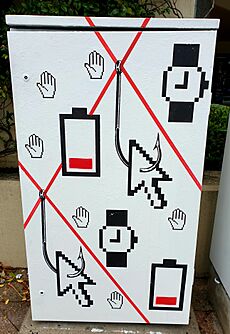Clickbait facts for kids
Clickbait is a term for a headline, picture, or link on the internet that is made to grab your attention and make you want to click it. The goal is to get you to visit a website, watch a video, or read an article.
The word "clickbait" is like the word "bait" used in fishing. In fishing, bait is used to trick a fish into biting a hook. In the same way, clickbait tries to "hook" you with a shocking or exciting headline to make you click.
These headlines often create a "curiosity gap." This means they give you a little bit of information to make you curious, but not enough to satisfy your curiosity. You feel like you have to click the link to find out the rest of the story. A big problem with clickbait is that the headlines are often misleading or don't tell the whole truth about the content you are about to see.
Contents
What is Clickbait?
A key feature of clickbait is that it tries to trick or manipulate you into clicking. It often promises something amazing or shocking, but the actual article or video is disappointing or not what you expected.
For example, a clickbait headline might say, "You'll Never Believe What This Celebrity Did!" or "The One Secret to Getting Straight A's!" When you click, the story is often boring, not true, or just a long advertisement.
While there is no single definition everyone agrees on, most people think of clickbait as a headline that:
- Is sensational or overly emotional.
- Intentionally promises more than the article delivers.
- Leaves out important information to force you to click.
Sometimes, people use the word "clickbait" just to describe an article they don't like, but true clickbait is about being dishonest in the headline to get more clicks.
Why Do People Use Clickbait?
Earning Money
The main reason clickbait exists is to make money. Many websites earn money from online advertising. The more people who visit their website (get page views), the more money they can make from the ads shown on their pages. A catchy, sensational headline gets more clicks, which means more visitors and more ad revenue for the website owner.
Going Viral on Social Media
Clickbait is very common on social media and video platforms like YouTube. A surprising title or an exciting thumbnail picture can make a video get millions of views. This is because people are more likely to click on and share something that looks shocking or interesting.
This is sometimes called engagement bait. This is when a post tries to trick you into interacting with it by asking you to "Like if you agree," "Comment with your favorite color," or "Tag a friend who does this." This artificial engagement helps the post get seen by more people.
Spreading Misinformation
Sadly, clickbait can also be used for harmful reasons. Some clickbait links lead to websites that try to spread phishing attacks to steal personal information like passwords. Others might try to trick you into downloading a computer virus. It's a good idea to be careful and think before you click on links that seem too good to be true.
Clickbait has also been used to spread false information or rumors. Headlines that cause strong emotions like anger or surprise get shared very quickly, even if the story isn't accurate. This can make it hard for people to know what is true and what is not.
The History of Clickbait
The ideas behind clickbait are not new. Long before the internet, a style of reporting called yellow journalism was popular in the late 1800s. Newspapers using yellow journalism would print eye-catching headlines with exaggerated stories and scandals to sell more copies. They cared more about getting attention than reporting the facts accurately.
Clickbait is like a modern, digital version of yellow journalism. Instead of selling newspapers, it's used to get clicks online.



